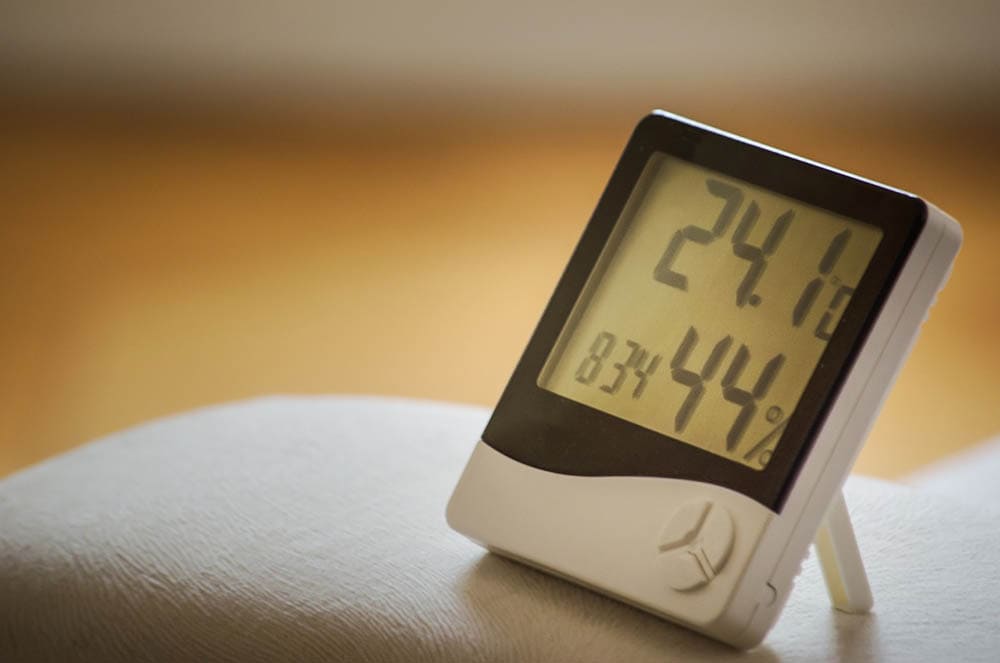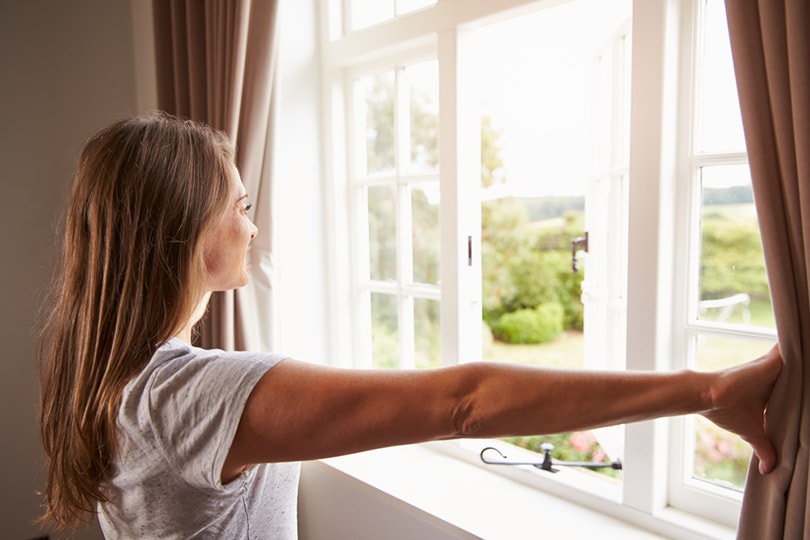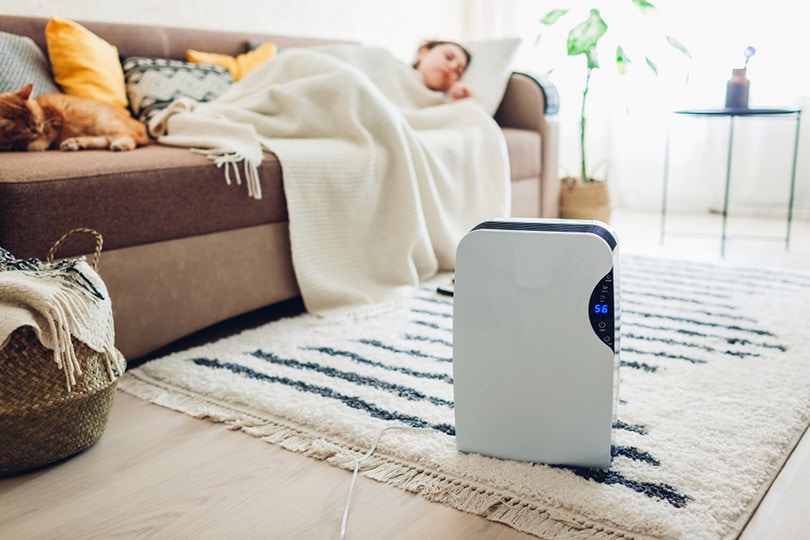What’s the Ideal Indoor Humidity Level for Summer? Causes, Tips, & FAQ
-
Pete Ortiz
- Last updated:

Humidity levels determine the overall comfort of your home. High humidity levels can promote the growth of mildew and mold. Contrary, low humidity can potentially damage furniture and dry your skin. During summer, humidity levels are usually higher than in the other seasons. This can make your home feel uncomfortably stuffy. To feel comfortable during summer, the ideal humidity should hover between 30%–50%.
In this article, we will discuss the different humidity levels during summer and winter, and the reasons for high humidity during summer. We will also tell you how to reduce humidity in your home and the difference between using air conditioning and a dehumidifier to increase humidity in your home.
Read on to learn more.
Seasonal Humidity Levels

Relative humidity is the amount of water vapor present in the air and is expressed as a percentage of the amount of moisture present in the air. Usually, anything under 30% is considered too dry and anything above 60% is too high. Therefore, it is important to be aware of the humidity levels in your home so that you can make appropriate adjustments to improve your comfort.
As the seasons change from hot to cold months, so do humidity levels. This is what is commonly referred to as seasonal humidity, and it affects the level of your body’s comfort and that of your home. During winter, people often say that the air is dry or crisp. In summer, humidity is described as muggy, heavy, or sticky. These are good descriptions of humidity levels throughout the year.
You must know the different humidity levels in hot and cold seasons so that you can manage them accordingly. To measure the relative humidity in your home, you can use a hygrometer. Alternatively, you can use weather station apps which you can install on your smartphone.
Normal Humidity Levels in Summer
In the warm summer months, the air tends to have more moisture. The high moisture content takes longer to evaporate, which consequently raises humidity levels. Typical summer months can record humidity levels even higher than 60% in some states. Therefore, the air feels heavier to breathe and causes people to sweat more.
Therefore, during summer, the Environmental Protection Agency (EPA)¹ recommends that you keep your indoor humidity levels between 30%–45%. Anything more than 50% will make your home very uncomfortable and promote the growth of mold in damp areas of your house.
To prevent further increases in humidity, you can utilize exhaust fans or an air conditioner. Using a humidifier during warm summer days is a huge No! Even if you have allergies, try to keep a minimum of 30% humidity.
Normal Humidity Levels in Winter
If you live in an area that experiences long and dark winter seasons, then your skin has probably experienced the effects of low humidity. Winter can be very detrimental to exposed skin. The cold draws out most of the moisture from the air, leaving a dry and sharp atmosphere behind with a humidity level below 30%. This is perhaps why, besides jackets and boots, deep moisturizers are essential gears for winter.
Therefore, during the cold winter months, it is crucial to restore moisture to the indoor atmosphere. It is best to maintain humidity levels around 40%. If you notice condensation on the windows, then the humidity is too high and can destroy your furniture. You can use a portable humidifier to increase the humidity of the rooms in your house. If you can, consider investing in a whole house humidifier for use during winter.
What Causes High Humidity in Your Home During Summer?
As you may have gathered by now, humidity is essentially moisture content in the air. Therefore, high humidity levels mean excess water vapor trapped in the atmosphere in your home. Curious about where it comes from? Mostly from us!
Indeed, besides the warm environmental conditions of summer, we are also to blame for the increased humidity levels in our homes. Our daily modern lives create a huge amount of moisture. In fact, a report¹ from The Institute of Specialist Surveyors and Engineers (ISSE) supports this claim by stating that our everyday activities generate moisture in the house, and these include:
- Sleeping, produces about 40 grams of water per hour through exhalation and perspiration.
- Typical housework produces about 90 grams of water through exhalation and perspiration.
- Cooking via a gas cooker or electric cooker produces about 3,000 grams of moisture per day.
- Doing laundry produces 500 grams of water per day
- Using a dishwasher produces 400 grams of moisture content per day.
- Drying clothes indoors produces 1500 grams of water per day.
Though rare, sometimes high humidity levels are caused by something more sinister like a leaking pipe. So, high humidity can also be a sign of larger underlying issues. Clearly, it doesn’t take much for humidity levels to rise in your home. Therefore, you should find appropriate means to reduce the high moisture content.
How to Reduce Humidity Levels in Your Home
Getting the ideal humidity level in your home can be a balancing act. However, it is worth the effort considering the myriad problems that can arise from high humidity levels. If you need to lower the humidity level in your home, consider these three tips.
1. Crack Open a Few Windows

Increasing air circulation in your house by opening a few windows is one of the simplest and most cost-effective ways of dealing with high humidity. During humid summer days, open a few windows and use a fan to help push out the stale air.
Since some house appliances like dryers add to the indoor moisture content, don’t use them, if possible, with closed windows. The only drawback to this method is that during summer, both the air inside and outside is usually very humid. Also, the temperatures will be higher, so opening a window will cause further discomfort.
2. Take Colder and Shorter Showers
Long hot showers significantly raise the moisture content level in your indoor atmosphere. The steam produced by the hot running water floats around for longer, hence increasing moisture build-up in the air.
To minimize moisture, take showers that last at least 10 minutes. Also, consider using cooler water than you are used to. Cold water will not only provide a reprieve from the hot heavy summer atmosphere but has several health benefits¹ too.
For optimum results, use a bathroom fan to help the air circulate after taking a shower. Also, if there is a bathroom window, open it. A low-flow shower head will also help reduce humidity levels in your washroom.
3. Use a Dehumidifier

If opening windows and taking cold showers don’t reduce the moisture content from your indoor air, you can take more drastic measures by purchasing a dehumidifier. This is a useful device, especially in older homes with poor ventilation. They are also great with moisture-rich environments such as storage spaces, laundry rooms, and damp basements that do not receive a lot of sunlight.
Dehumidifiers are designed to absorb excess moisture from the air. They work by moving air over refrigerated coils, which suck moisture content from the air and deposit it into a tank.
Air Conditioning vs. Dehumidifiers
An air conditioner can help reduce the moisture content in your home and is quite an effective solution, especially during summer. Yet, its most significant drawback is that this home fixture is not specifically designed to maintain a balanced relative humidity level. Actually, it can dry the air in your home too much, especially if left to run for prolonged periods.
If you spend time in a room where the AC has been running for a while, you are likely to notice your eyes and skin getting irritated, inflamed allergies, and sinus issues because the air is not humid enough.
If your AC is drying up your air too much, you could opt to use a dehumidifier to make your summers more comfortable indoors. You can even run the AC and a dehumidifier at the same time for maximum results.
The AC will keep a stable temperature while the dehumidifier maintains the perfect humidity level in your home. Cool mist humidifiers are great for summer because they reduce humidity without adding to the heat. They are cheaper and better suited for hotter environments

Frequently Asked Questions
Can humidity variations affect my health?
High humidity can irritate the mucous membrane in the nose and throat. It can also cause breathing difficulties in at-risk individuals and eye irritation.
Do houseplants have any effect on humidity?
Potted houseplants can increase the humidity in your home. This happens through the process of transpiration which releases moisture in the air.
Are there tell-tale signs of humidity variations?
If you don’t have a hygrometer, you can look for early signs of variations in moisture in the air. Early signs include cracked paint and static electricity.
Conclusion
The ideal humidity level for summer should range between 30% and 50%. These levels vary from summer to winter; thus, it is essential to check the humidity level using a hygrometer and other tools.
High humidity levels in the house can have adverse effects on your health and can destroy furniture. It can also promote the growth of mildew and mold. So, to combat high humidity levels that are experienced during summer, consider taking a colder and shorter shower.
Alternatively, you can simply open a window to let the stale moist air out. If that doesn’t work, get a dehumidifier to balance ambient humidity levels in your house.
Featured Image Credit: Matt Sawyers, Pixabay
Contents




